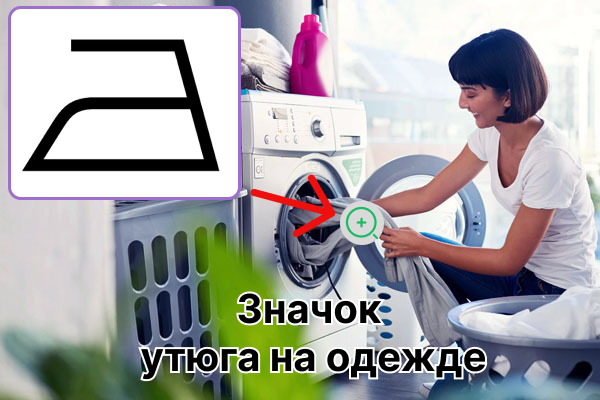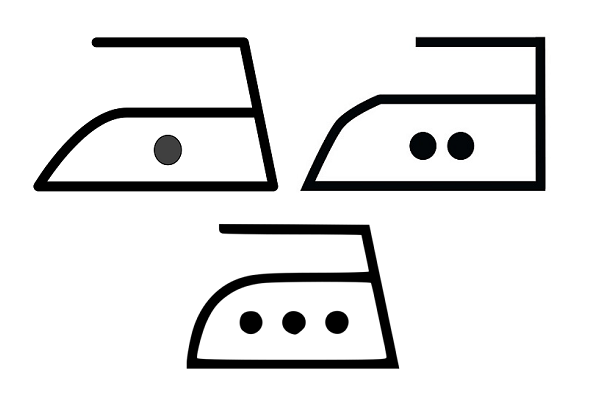What does the iron icon on clothes mean: explanation and care recommendations
On almost all modern clothing you can find labels with specific icons, which translate into certain rules for caring for the product. One of the most significant symbols is the iron sign on clothing, indicating, respectively, the permitted and/or prohibited ironing rules for a particular product.

Recommendations
It is important to emphasize that the recommendations, which are clearly encoded in the iron icon on the clothes, nevertheless leave enough freedom for simple care of the clothes.
This basic schematic image has the simplest possible meaning and should be interpreted as an indication that the item can, in principle, be ironed. And by default, it is believed that it can be ironed at the minimum temperature of the iron sole and without the use of steam.
What does it look like
An iron is really easy to spot in the outline of this icon. It is depicted as an outline of a household appliance with an open handle.
On the tags of products made from natural wool, you can find the same iron symbol, but enclosed in a circle, which means that in order to preserve the item and properly care for it, it should be ironed at a temperature not exceeding 140°C.
The symbol of steam emanating from the bottom of the iron is also easily recognizable. If it complements the symbol, then it should be understood to mean that steaming is permitted.
However, these are not the only possible images of the iron. It is often printed on a label with one, two or three dots in the body. These symbol elements refer to the recommended maximum ironing temperature for the product.
One point indicates that the iron can heat up to no more than 110-115°C, that is, it needs to be ironed at a low temperature. This type of care usually corresponds to:
- silk;
- nylon;
- chiffon;
- viscose.
This broad group also includes polyamide fabrics and some others, also distinguished by their exquisite, fragile delicacy.
Two dots on the iron symbol serve as a clear indication that the product can be ironed at maximum heating of the soleplate to 150-155°C, which is the average temperature range. It is believed that it is optimally suited for products:
- sewn from polyester;
- woolen;
- semi-woolen;
- sewn from thin cotton fabrics.
Three dots indicate the highest temperature regime, corresponding to heating the working surface of the equipment to 200-205°C. This ironing is recommended for solid fabrics, including:
- thick cotton;
- drape;
- linen;
- denim without impurities.
In fact, the absence of dots in the iron icon on a clothing label means that the temperature regime is, in principle, not important for ironing.
Helpful advice.It is not enough to just have a good iron and labels on your clothes that define the rules for its use. For proper care of products, a suitable surface is also required. The ironing board should have a soft, but at the same time hard coating that cannot burn. It is recommended to give preference to metal rather than plywood products. In addition, steaming things is only allowed on boards that have special perforations.

What not to do

Note! If the iron icon itself is not crossed out, but there are two curved and crossed out lines under it, such a symbol always means that when ironing a thing, it is contraindicated to steam it.
What can you do

| Designated thermal regime | Minimum temperature | Recommended temperature |
| • | 75°С | 95°C |
| •• | 130°С | 130°С |
| ••• | 145°С | 175°С |
Questions and answers
Is it possible to iron clothes, focusing on the items already in your wardrobe, ignoring the icons on the clothes?
This is not recommended for the reason that some fabrics (and this is especially true for synthetics) are made using generally similar technologies, but with possible differences in production processes. In this regard, the output materials are slightly different. And the ironing mode that was suitable for one thing may turn out to be inappropriate, literally disastrous for something similar to it, but still different.
Is it worth heating the soleplate of the iron to the maximum maximum?
This should only be done if the fabric has great difficulty coming into order at lower temperatures. In addition, the iron’s thermostat must work flawlessly, because theoretically, its failure even within 5-10 degrees upward may be unacceptable for some fabrics, in particular such delicate ones as natural silk and chiffon.
Is it possible to simply iron slightly damp items when steaming is prohibited?
This temptation may arise because there is a common myth that damp fabrics are easier to iron. However, in the case where the manufacturer of the product clearly indicated on its label that this method of care is inadmissible, it is contraindicated to try to replace it with something. Theoretically, at best, such a cunning technique will lead to the fact that the item will never be ironed properly. But what is more likely is that it will be hopelessly damaged.
To conclude the topic, we can say that the iron sign on a clothing label is not the most significant of the elements that inform the end consumer on the product label about how to properly care for it.Having at hand the exact decoding of the iron icon, you can never worry about what ironing temperature and accompanying actions you can choose for your things.
